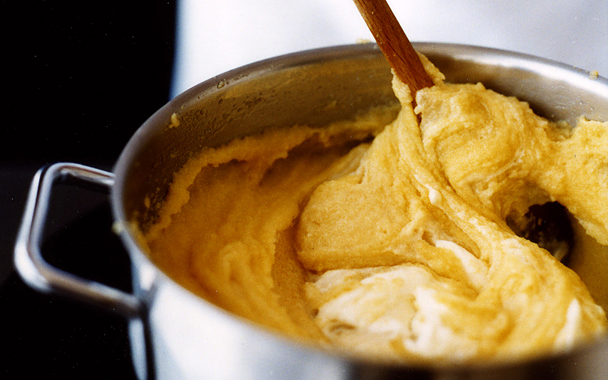What some people call peasant food is what I call the way I like to eat. My cabinets are always filled with gemelli and rotini, and cornmeal for the polenta that shows up at least a couple times a week for dinner (typically topped with my standby combination of sautéed onions, garlic, eggplant, and San Marzano tomatoes). In good times or hard times (when grocery lists veer toward the old standby starches and away from the rib-eyes), I eat polenta. It might be said that I enjoy dishes that don’t require much cooking beyond adding water and salt and stirring. That would not be a lie. But I also appreciate polenta (sometimes referred to as Italian grits) because it works as a platform for just about any dish, from osso buco to garlicky collards.
I’m not a fickle polenta lover. I don’t turn my back on my favorite comfort food when the thermometer rises above 50 degrees. I just shift a little, from the creamy hot-from-the-pot variety that warms me on winter days to the more cakelike form, maybe baked with Parmesan and served with a crisp salad of dressed mâche.
Plenty of chefs share my serious crush on cornmeal mush. In New York City alone, those who do great things with polenta include Mario Batali; Frank DiCarlo, at Peasant; and Michael White, at Convivio. At the new Swiss place Café Select, Serge Becker serves Eggs Ticinese, a dish that recalls Switzerland’s Italian-influenced south: creamy soft polenta topped with poached eggs and ham. At Allen and Delancey, a clubby young place on the Lower East Side, executive chef Kyle Bailey fries his polenta until it’s nice and crisp, then tops it with a mushroom ragù, artichokes, and Sottocenere fonduta. Bill Telepan, who has always had a soft spot in his heart for polenta, is turning out a fallen polenta soufflé (white corn hominy, wild mushrooms, crushed shell beans, corn bread brown butter) at Telepan. And Scott Conant, at Scarpetta, makes a creamy polenta with a fricassee of wild mushrooms—a dish as close to the platonic ideal of polenta as you can find. Soothing and soft, with earthy undertones, it may be the most delicious dish I’ve ever eaten, and the one that, having begged him for the recipe, I turn to whenever I need the food equivalent of a pacifier. (He was kind enough to let me reprint it below.)
In The Old World Kitchen, one of my bibles of peasant cookery, writer Elisabeth Luard says that polenta was originally made with chestnut flour, but when corn came from the New World to Northern Italy, polenta changed with it. And what began as a Northern Italian staple eventually became beloved throughout the country, in two very different forms: a creamy mush; and relatively solid cakes that could take the place of pasta or bread at a meal.
Whatever style you prefer, the key to cooking perfect polenta is to start with regular polenta or yellow cornmeal, not quick-cooking or stone ground varieties (stone-ground creates too fine a mixture; you want the coarser texture that regular polenta or yellow cornmeal provides). And take your time—long, slow cooking is best. Start with creamy polenta with Parmigiano-Reggiano, or take an alternative route to it with food editor Melissa Roberts’s polenta-crusted chicken with balsamic caper pan sauce. And if that’s peasant food, I never want to be rich.
Scott Conant’s Creamy Polenta with a Fricassee of Mushrooms and Truffle Reduction
Ingredients for the Polenta:
4 oz polenta
1 cup heavy cream
1 cup milk
1 tbs butter
2 tbs freshly grated Parmigiano-Reggiano
Salt
Chives for garnish
Ingredients for the Fricassee of Mushrooms:
1/4 lb chopped fresh Porcini mushrooms
1/2 shallot, sliced
1 cup chicken reduction
2 tbs extra-virgin olive oil
Truffle oil to taste
Method:
For the polenta: Add the milk and cream together in a medium saucepan and heat to scald. Add salt to taste, and, off the flame, add polenta slowly while stirring. Lower heat, return pan to stove, and stir regularly for an hour. Keep covered.
For the mushrooms: Add olive oil to sauté pan, heat until almost smoking, then add shallots. When the shallots start to caramelize, add sliced porcini. When the porcini begin to exude their juices add the cup of chicken reduction and cook over medium-high heat until reduced by 2/3.
To finish: Stir butter and Parmigiano into polenta, then spoon on to plate. Set sautéed mushrooms on top of polenta and pour juice from pan over the top. Garnish with snipped fresh chives.
Yield: 4

